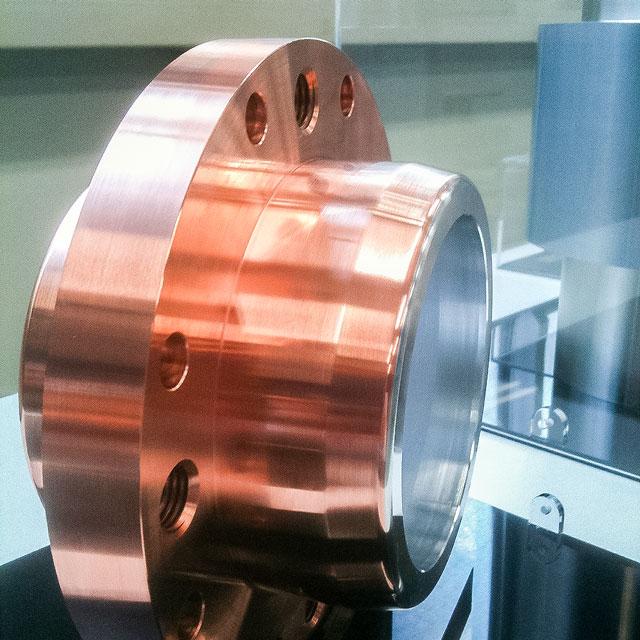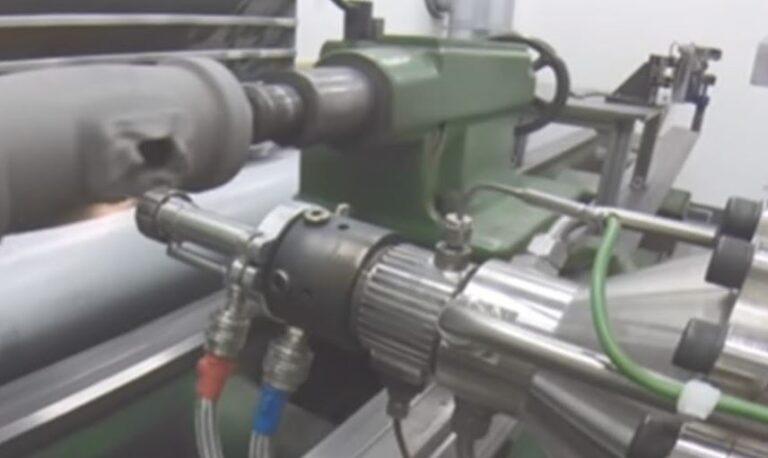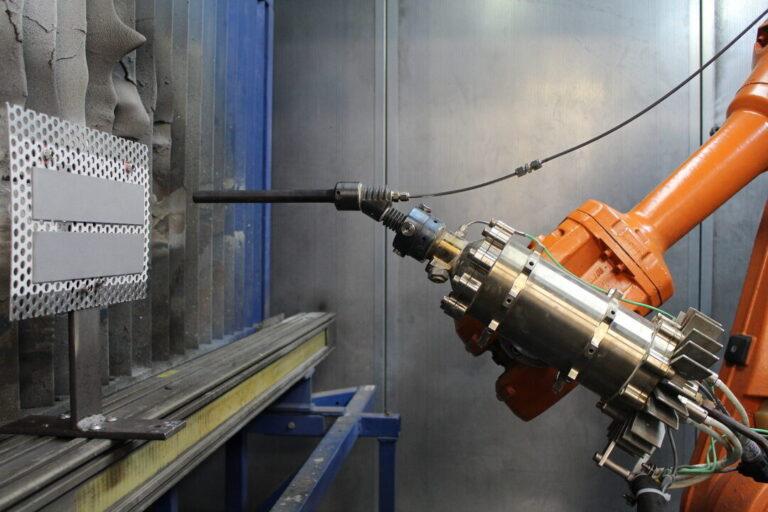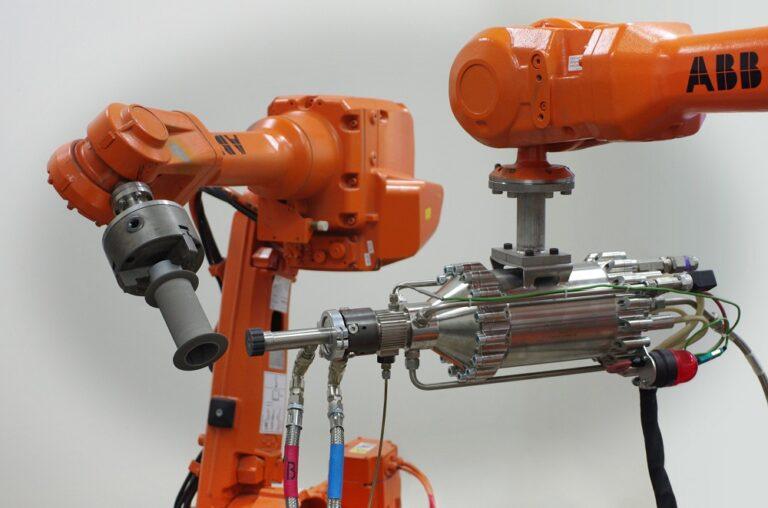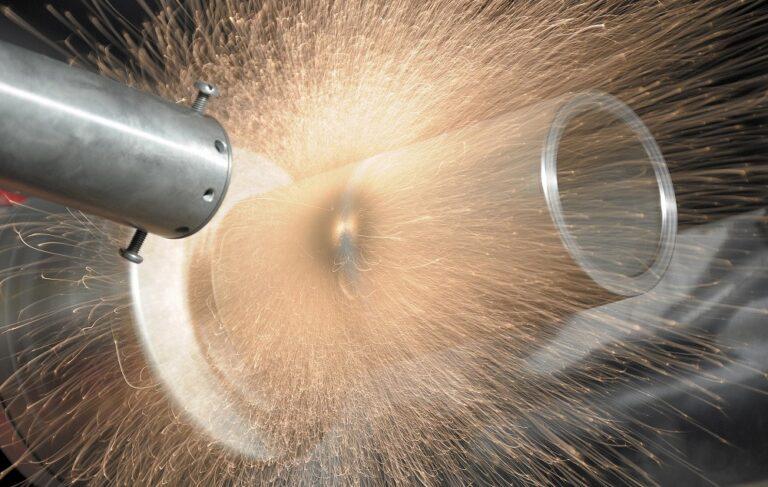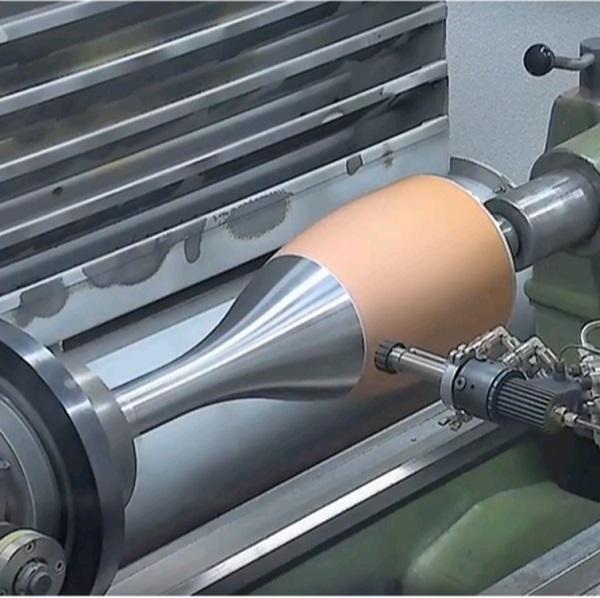Introduction to Cold Spray Coating
Cold spray coating is a process that utilizes compressed gas to accelerate particles of material toward a substrate. Unlike traditional coating methods, cold spray does not involve the use of heat or solvents. Instead, the kinetic energy generated by the high-speed particles of material creates a strong bond between the substrate and the coating.
Explanation of the technology
Cold spray coating technology involves the use of a specialized gun that mixes compressed gas, typically nitrogen or helium, with particles of material, such as metals, ceramics, or polymers. The resulting mixture is accelerated to supersonic speeds and sprayed onto the substrate. The impact of the particles on the surface of the substrate causes the coating to adhere and bond with the material.
Materials
Cold spray coating can be applied to a wide range of materials, including metals, ceramics, and polymers. The technology allows for the use of powders that are otherwise difficult to apply with traditional coating methods, such as those with high melting points or those that are reactive with oxygen. The cold spray also enables the use of composite materials and the creation of unique material combinations.
Advantages over other coating methods
Compared to other coating methods, cold spray offers several advantages. The process is environmentally friendly, as it does not involve the use of solvents or other harmful chemicals. It is also a low-temperature process, which makes it ideal for coating materials that are sensitive to heat. Additionally, cold spray can produce coatings that are dense, uniform and possess high mechanical properties.
In this blog, we will focus on providing a comprehensive education on cold spray coating, including techniques, materials, and process control. By the end of this blog, you will have a thorough understanding of cold spray coating and its applications in various industries.
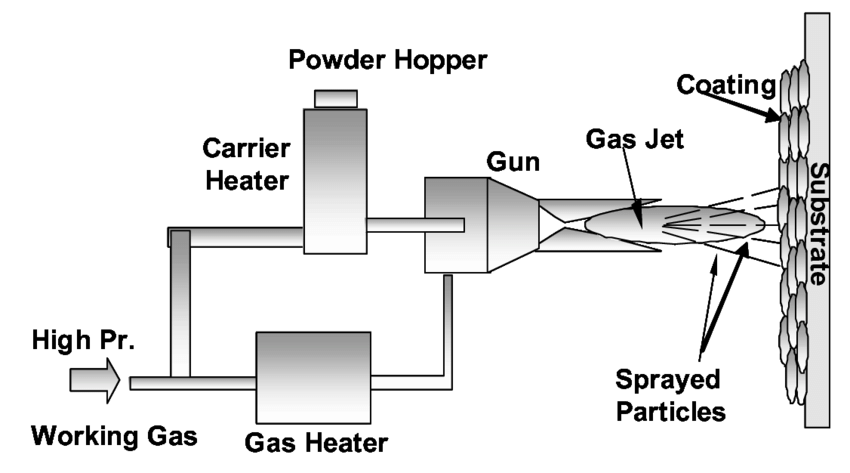
Surface Preparation
Before beginning the cold spray coating process, it’s essential to properly prepare the surface. This involves cleaning and removing any contaminants, such as oils, grease, or rust, that could impact the adhesion of the coating. Surface preparation methods can include sandblasting, wire brushing, or chemical cleaning. Proper surface preparation is crucial for achieving a high-quality, uniform coating with excellent adhesion to the substrate.
In addition, surface roughness can also impact the coating’s adhesion strength. To promote better bonding between the coating and the substrate, one should uniformly roughen the surface. The optimal surface roughness depends on the specific material being coated and the application requirements.
Overall, proper surface preparation is a critical step in achieving a successful cold spray coating. By ensuring the surface is clean and appropriately roughened, the coating will bond well with the substrate, resulting in a durable, high-quality finish.
Material Selection
Choosing the right material is critical for achieving a successful cold spray coating. Metals, ceramics, and polymers are commonly used materials in cold spray coating applications.
metals
The metals are ideal for applications that require high strength, durability, and wear resistance. Commonly used metals include aluminum, copper, and titanium. They can be coated using cold spray to enhance their surface properties or repair damaged parts.
ceramics
Ceramics are suitable for applications that require high-temperature resistance, electrical insulation, and wear resistance. Examples of ceramic materials include tungsten carbide, alumina, and zirconia. Cold spray can be used to apply ceramic coatings to improve the surface properties of parts or create unique material combinations.
polymers
People often use polymers in applications that need chemical resistance, flexibility, and ease of processing. You can use cold spray to apply polymer coatings to surfaces or repair damaged parts.
Overall, selecting the appropriate material for a cold spray coating application is crucial for achieving the desired surface properties and ensuring the longevity of the coated part. By choosing the right material and applying it using a cold spray, the coated part can exhibit enhanced properties and improved performance.
In conclusion, cold spray coating technology provides a versatile platform for coating various materials, including metals, ceramics, and polymers. Careful consideration of the material selection ensures optimal surface properties, enhancing the performance and longevity of the coated parts.
Process Control
Proper process control is essential for achieving high-quality and uniform cold spray coatings. Temperature, pressure, and nozzle design are critical factors that must be carefully controlled during the cold spray coating process.
temperature
The Temperature plays a crucial role in the cold spray process, affecting particle velocity and adhesion strength. Controlling temperature is essential for achieving consistent coating quality and optimizing the coating’s properties.
pressure
Pressure also plays a vital role in the cold spray process, affecting particle acceleration and velocity. Controlling gas pressure is critical for achieving the desired coating properties and preventing coating defects.
nozzle design
The nozzle design is another critical factor that affects the cold spray process. Proper nozzle design can help control particle velocity and prevent coating defects such as splattering or delamination.
Overall, process control is essential for achieving consistent and high-quality cold spray coatings. The cold spray process can optimize to achieve the desired coating properties and prevent defects by controlling temperature, pressure, and nozzle design.
In conclusion, careful control of temperature, pressure, and nozzle design is critical for achieving high-quality and uniform cold spray coatings. Controlling these factors can optimize the cold spray process to produce coatings that enhance surface properties and improve the performance and longevity of coated parts.
Coating Thickness
Coating thickness is a critical factor that affects the performance and longevity of cold spray coatings. Several factors, including particle velocity, nozzle design, and coating material properties, can influence the coating thickness.
Particle velocity plays a crucial role in determining the coating thickness. Higher particle velocities can lead to thicker coatings, while lower velocities result in thinner coatings. Nozzle design also plays a role in determining the coating thickness. Nozzles with larger diameters tend to produce thicker coatings than smaller nozzles.
In addition to particle velocity and nozzle design, the coating material properties also affect the coating thickness. The particle size distribution, morphology, and adhesion properties of the coating material all play a role in determining the coating thickness.
Achieving the desired coating thickness is essential for optimizing the coating’s properties and ensuring the longevity of the coated part. Controlling particle velocity, nozzle design, and coating material properties allows for careful and optimized control of the coating thickness for the specific application.
In conclusion, coating thickness is a critical factor that affects the performance and longevity of cold spray coatings. By controlling particle velocity, nozzle design, and coating material properties, one can carefully control and optimize the coating thickness to achieve the desired coating properties and ensure the longevity of the coated part.
Surface Finishing
Surface finishing is an essential step in cold spray coating to ensure the quality of the final product. The factors affecting the surface finish include particle size and distribution, nozzle design, substrate preparation, and coating thickness. A smooth surface finish is essential for the performance and durability of the coated surface. A rough surface can cause adhesion and wear problems. The surface finish can be improved by using post-treatment processes such as grinding, polishing, and shot peening. Cold spray coatings can achieve excellent surface finishes with proper process control and post-treatment.
Applications of Cold Spray Coating
In many different industries, cold spray coating has several uses. The field of aerospace employs cold spray coating to maintain and improve the functionality of turbine blades and engine casings. The automotive industry uses cold spray coating to increase the wear resistance and corrosion protection of engine and transmission parts. Medical professionals apply cold spray coating to improve the biocompatibility of implantable medical devices, including dental and orthopedic implants.
aerospace
Many industries use cold spray coating, including aerospace, automotive, and medical sectors. In the aerospace industry, they use cold spray coating to protect and repair airplane components, such as the engine and landing gear. For instance, NASA has restored the surface of the Space Shuttle engines using cold spray painting.
automotive
Cold spray coating is used in the automotive industry to prevent corrosion and increase the wear resistance of engine parts including piston rings and bearings. By lowering friction in engine parts, cold spray coatings can help increase a vehicle’s fuel efficiency. The repair of the hood of the original Batmobile is a well-known illustration of the use of cold spray coating in the automotive sector.
medical sectors
Cold spray coating is used to coat medical implants with biocompatible materials, such as dental and orthopedic implants, to prevent body rejection. Additionally, cold spray coating can repair and restore medical equipment such as surgical tools and X-ray machines. For instance, surgical scissors’ precise blades have been repaired using cold spray coating.
Finally, cold spray coating has established itself as a flexible technology with a range of uses in the aerospace, automotive, and medical sectors. It has become a desirable solution for various industries due to its capacity to offer wear resistance, corrosion protection, and biocompatibility, as well as the ability to repair and recover components.
Troubleshooting
Troubleshooting is an important aspect of cold spray coating. The general principles of troubleshooting in cold spray coating involve identifying the problem, determining the root cause, and implementing corrective actions. Factors that may affect the process include material selection, surface preparation, process control, and coating thickness.
Common issues in cold spray coating include poor adhesion, low coating density, surface defects, and inadequate coating thickness. These issues can be caused by several factors, including improper surface preparation, incorrect process parameters, and improper nozzle design. Other potential issues include insufficient gas supply, inadequate powder feed rate, and equipment malfunction.
To troubleshoot these issues, it is important to conduct a thorough analysis of the process parameters, equipment, and materials. This can involve adjusting process parameters such as gas temperature and pressure, powder feed rate, and nozzle design. It may also require performing surface preparation to ensure proper adhesion. In some cases, equipment repairs or replacement may be necessary.
Overall, troubleshooting in cold spray coating requires a systematic approach to identify and address the root cause of any issues. By understanding the factors that affect the process and recognizing the common issues that may arise, it is possible to implement corrective actions and ensure high-quality coatings.
Safety Considerations
Cold spray coating technology requires specific safety considerations to ensure the safety of the operator and the equipment. The operator should wear adequate personal protective equipment (PPE), such as gloves, safety glasses, and respiratory protection while operating the cold spray coating equipment. Moreover, the operator must undergo proper training to safely operate the equipment and handle the materials used in the process.
Furthermore, it is essential to maintain the equipment in good condition and to perform routine inspections and maintenance to prevent any malfunctions that could cause safety hazards. Authorized personnel should keep the area around the cold spray coating equipment clean and free of clutter to prevent tripping hazards. They should also restrict access to the equipment.
In addition to these safety measures, it is also essential to consider the potential environmental impacts of the cold spray coating process. Proper ventilation and air filtration systems should be in place to prevent the release of hazardous materials into the environment.
Key safety considerations for cold spray coating include wearing proper PPE, proper training of operators, routine maintenance and inspections of equipment, and environmental considerations.
List of key safety considerations
- Wear appropriate personal protective equipment (PPE) during operation.
- Properly train operators in the safe operation of the equipment and material handling.
- Maintain equipment in good condition and perform routine inspections and maintenance.
- Keep the area around the equipment clean and free of clutter.
- Restrict access to the equipment to authorized personnel only.
- Implement proper ventilation and air filtration systems to prevent environmental hazards.
Future Developments
In recent years, cold spray coating has emerged as a promising technology with potential applications in a variety of industries. As with any technology, there is always room for improvement and development. In this section, we will discuss some of the possible future developments in cold spray coating technology.
Firstly, hardware development is essential for improving the capabilities of cold spray systems. Higher pressure and temperature capabilities, improved powder feed systems, and nozzle designs can all contribute to better coating quality and efficiency.
Secondly, software and firmware development can also improve the accuracy and precision of the cold spray coating process. These improvements could help reduce waste and improve the quality of the coatings produced.
Thirdly, advancements in materials science could lead to new powders and coatings with superior properties, such as improved wear resistance, corrosion resistance, and thermal properties. This could lead to new applications and markets for cold spray coatings.
Fourthly, the use of alternative gases, such as helium, nitrogen, or carbon dioxide, could provide new opportunities for cold spray coating. These gases could enable the deposition of a wider range of materials and improve coating quality and efficiency.
In conclusion, cold spray coating technology has shown great potential for a wide range of applications. Future developments in hardware, software, materials, and gases could further expand the possibilities of this technology and lead to new markets and applications.
Conclusion
In conclusion, cold spray coating is a promising technology with a wide range of potential applications in various industries. Its ability to produce dense, high-quality coatings with excellent adhesion and low thermal damage makes it an attractive alternative to traditional coating methods.
Key takeaways from this post include the importance of controlling the process parameters to achieve the desired coating properties, the need for proper surface preparation and substrate selection, and the potential benefits of using cold spray coating in industries such as aerospace, automotive, and medical.
As the development of cold spray coating technology continues, there is a growing need for collaboration between researchers, manufacturers, and end-users to explore new materials, optimize process parameters, and further improve the performance and reliability of cold spray coatings.
In light of these opportunities, it is important to encourage and support continued research and development in the field of cold spray coating, as it has the potential to revolutionize many industries and lead to the creation of innovative, high-performance products.
How to evaluate the quality of a cold spray coating?
- Visual Inspection
Examine the coating for any visible defects such as cracks, voids, or uneven thickness.
- Adhesion Test
Perform a tape test or crosshatch test to evaluate the adhesion strength of the coating.
- Hardness Test
Use a hardness tester to measure the hardness of the coating.
- Porosity Test
Perform a dye penetrant test to detect any porosity or defects within the coating.
- Microstructure Analysis
Use a microscope to examine the coating’s microstructure for any defects or anomalies.
- Corrosion Test
Expose the coating to a corrosive environment and monitor for any signs of corrosion.
- Performance Test
Test the coated component under real-world conditions to evaluate its performance and durability.
FAQs
A wide range of materials can be used for cold spray coating, including metals, ceramics, polymers, and composites. The selection of material depends on the specific application and requirements.
Yes, cold spray coating can be applied to complex shapes and surfaces, including concave, convex, and irregular surfaces. This is because the process does not require high temperatures, which allows for precise control of the coating.
Cold spray coating differs from other coating methods in that it does not require high temperatures or a chemical reaction to bond the coating material to the substrate. Instead, the coating particles are accelerated to high speeds and impact the substrate, resulting in a mechanical bond.
The advantages of cold spray coating include low heat input, high deposition efficiency, low oxidation and distortion, the ability to coat a variety of materials, and the ability to produce dense, high-quality coatings.
Yes, cold spray coating is considered environmentally friendly as it produces no harmful emissions or waste materials, and uses no solvents or chemicals.

